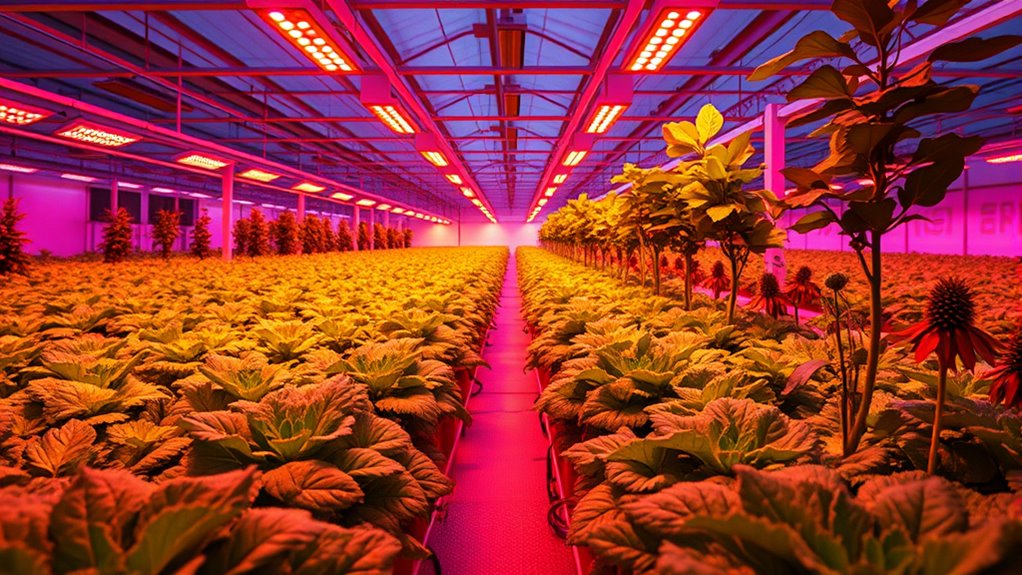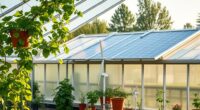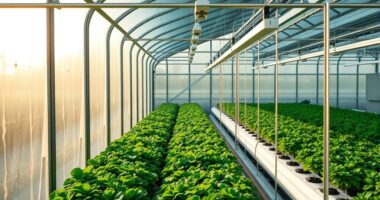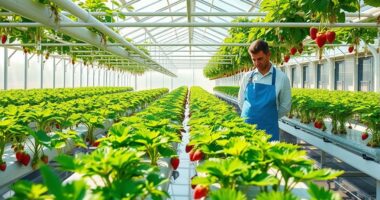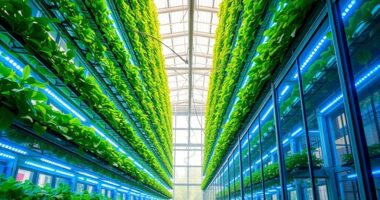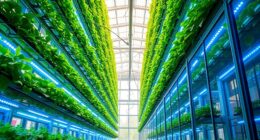To use grow lights effectively in your greenhouse, select the right type like LED or HPS based on your plants’ needs and budget. Install them properly, hanging lights 12-24 inches above plants and ensuring safe electrical connections. Adjust light intensity and duration to match growth stages, and monitor your system regularly for consistent coverage. Avoid common mistakes, and fine-tune settings as plants develop. Keep exploring to learn how to maximize your greenhouse’s productivity with ideal lighting techniques.
Key Takeaways
- Choose the appropriate grow light type and spectral spectrum based on your plants’ growth stages.
- Position lights 12-24 inches above plants and secure fixtures to ensure even light distribution.
- Adjust light intensity and duration with timers and dimmers to match plant needs and growth phases.
- Regularly inspect, clean, and replace bulbs to maintain optimal light levels and prevent malfunctions.
- Tailor light schedules and spectra to promote healthy growth, flowering, and maximize yield.
Types of Grow Lights and Their Features
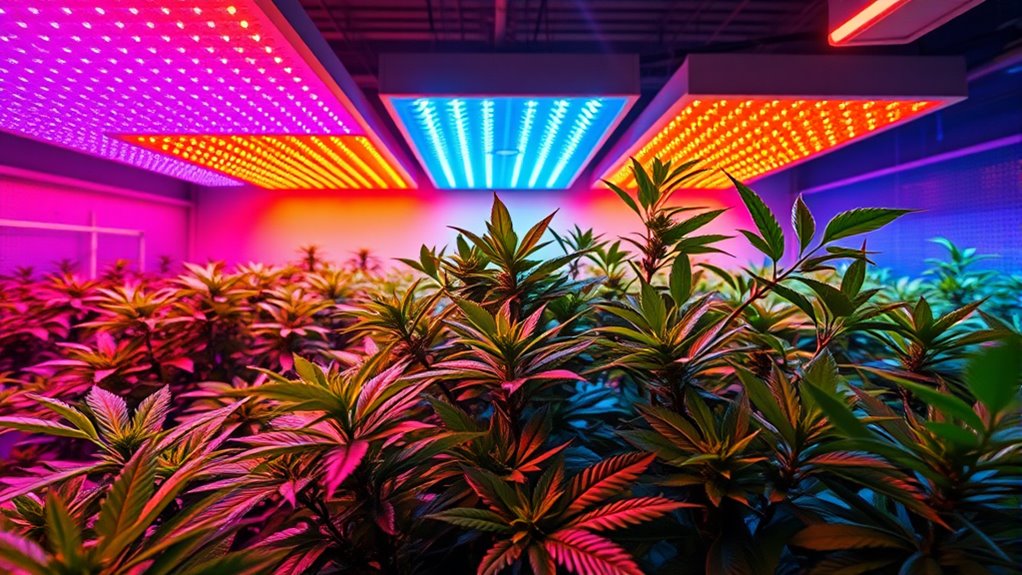
When choosing grow lights for your greenhouse, understanding the different types and their features is essential. LED options are popular because they’re energy-efficient, durable, and emit less heat. They come in various spectral variations, allowing you to tailor the light spectrum to your plants’ needs. High refresh rates in grow lights can help promote uniform light distribution, which is beneficial for plant growth. Some LEDs focus on specific wavelengths, promoting flowering or vegetative growth, while others offer full-spectrum lighting similar to natural sunlight. Fluorescent lights provide a budget-friendly option with moderate spectral variation, suitable for seedlings and small setups. High-intensity discharge (HID) lights, like metal halide and high-pressure sodium, deliver intense light but consume more energy and produce heat. Spectral variation is a key factor in choosing the right grow light, as different wavelengths can influence plant development stages. Additionally, understanding how different light intensities impact plant growth can help optimize your greenhouse conditions. Recognizing the importance of AI safety in technological advancements can also inform your decisions when integrating new lighting technologies and automation systems, ensuring safe and effective operation. Knowing the spectral variation and features of each type helps you select the best grow lights for your greenhouse’s specific requirements.
Choosing the Right Grow Lights for Your Greenhouse
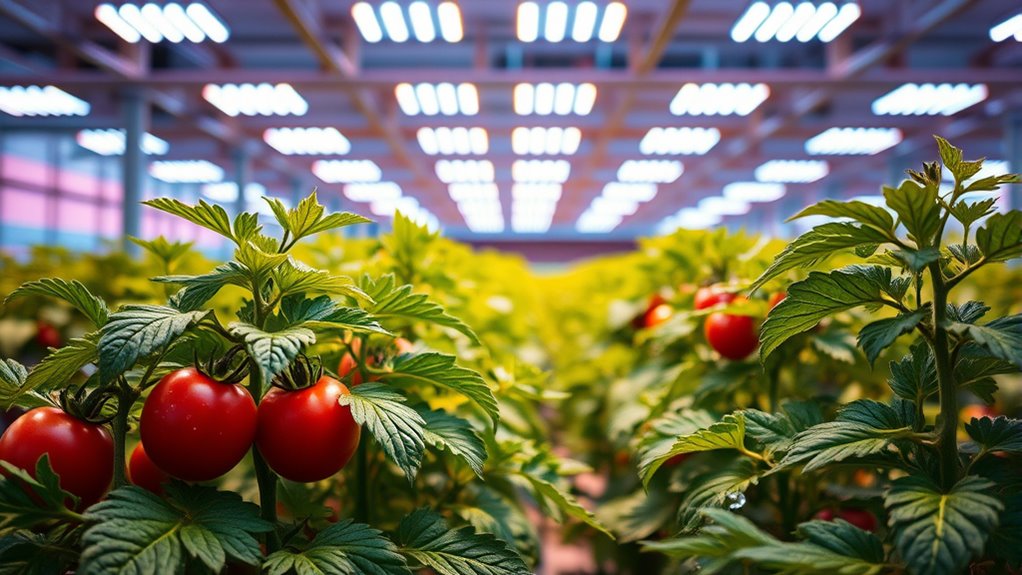
Selecting the right grow lights for your greenhouse hinges on understanding your plants’ specific needs, your budget, and environmental conditions. Different plants require varied light spectrums to enhance plant nutrition and growth. For example, some may need full-spectrum lights to support photosynthesis and nutrient uptake, while others benefit from targeted wavelengths. Incorporating energy-efficient lighting principles into your lighting setup can help identify vulnerabilities in your electrical system, ensuring safety and efficiency. Considering the antioxidant content of certain honey varieties can also inform your approach to maintaining healthy plants, as antioxidants support plant resilience. Consider how your lighting choices influence pest management—proper lighting can deter pests or reduce mold issues. Energy efficiency is also key; LED grow lights are cost-effective and produce less heat, helping maintain ideal environmental conditions. Additionally, understanding plant-specific lighting requirements can significantly improve overall plant health and yield.
Proper Placement and Installation of Grow Lights
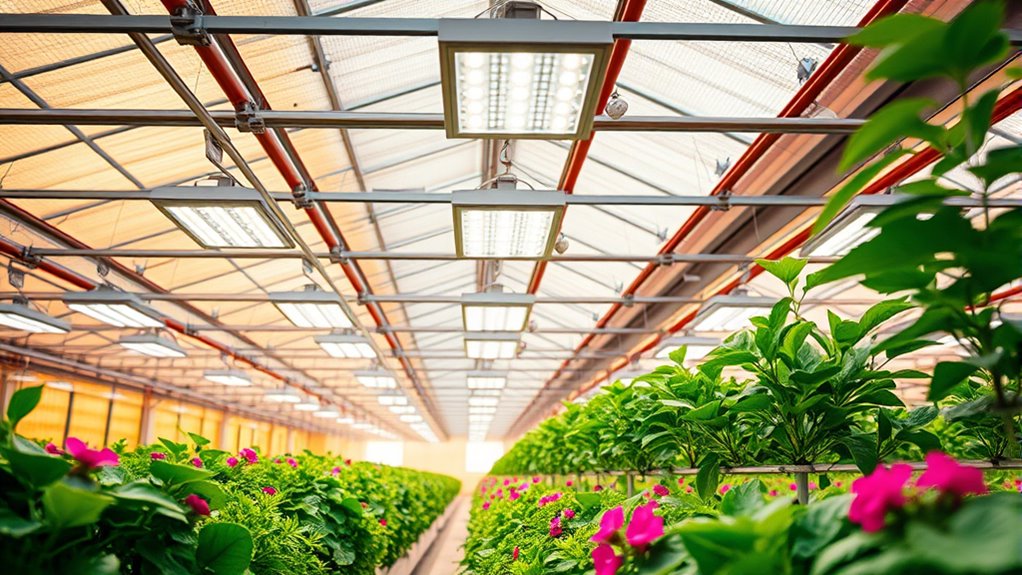
To guarantee your grow lights effectively support plant growth, proper placement and installation are essential. Start by carefully considering light fixture positioning; hang lights at the right height to ensure even coverage without causing heat stress. Typically, keep fixtures 12 to 24 inches above plants, adjusting as needed for your specific setup. Incorporating data-driven strategies can help you optimize light placement based on your greenhouse’s unique environment. Proper installation also involves ensuring adequate electrical safety, including using grounded outlets and maintaining good condition cords. Securely mount the lights to prevent shifting or falling. Always prioritize electrical safety by using grounded outlets and ensuring cords are in good condition. Avoid overloading circuits, and keep electrical connections away from water sources. Implementing portable electrical safety devices can further enhance safety measures. Additionally, understanding the best types of grow lights and their specific applications can significantly improve your setup’s effectiveness. Selecting appropriate lighting spectrum can promote healthy plant development. Proper installation not only maximizes light efficiency but also minimizes hazards, creating a safe environment for you and your plants. Taking these steps ensures your grow lights operate effectively and safely throughout your greenhouse.
Adjusting Light Intensity and Duration for Optimal Growth
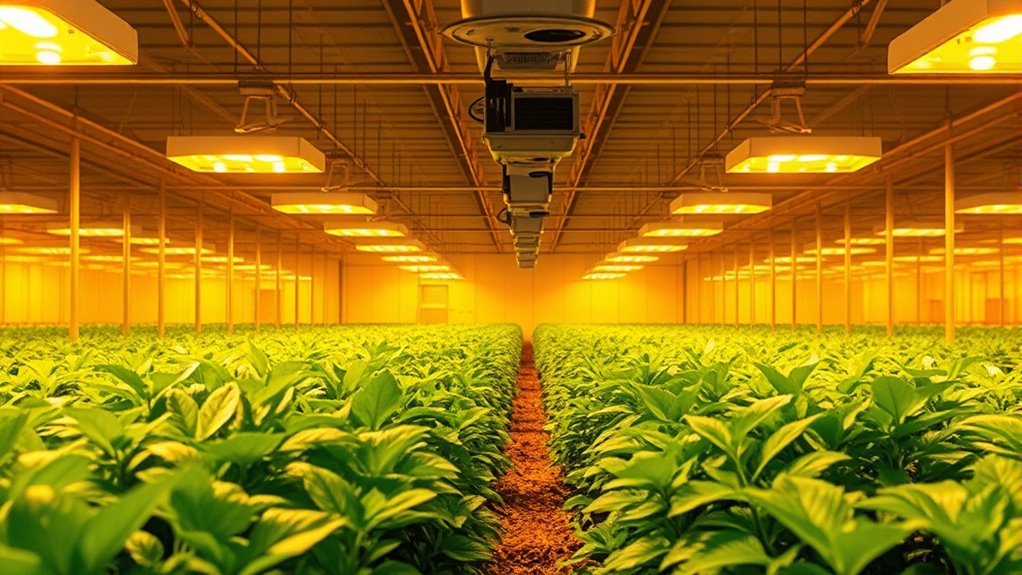
Once your grow lights are properly installed, adjusting their intensity and timing becomes key to promoting healthy plant growth. You can control light intensity to match your plants’ needs, ensuring they receive enough energy without overstressing them. Use dimmable lights or adjust the height to modify brightness. The light color also influences growth; for example, blue light promotes vegetative growth, while red encourages flowering. Tailoring the light spectrum and intensity helps optimize photosynthesis. Incorporating smart features, such as timers or automatic dimming, can further enhance your control over light conditions. Additionally, understanding the specific light requirements of your plant species allows for more precise adjustments. Keep in mind that different plants require different light durations—some need 12-16 hours of light daily, while others thrive with less. By fine-tuning both light intensity and duration, you create an environment that supports robust, healthy plants and maximizes your greenhouse’s productivity.
Monitoring and Maintaining Your Grow Light System
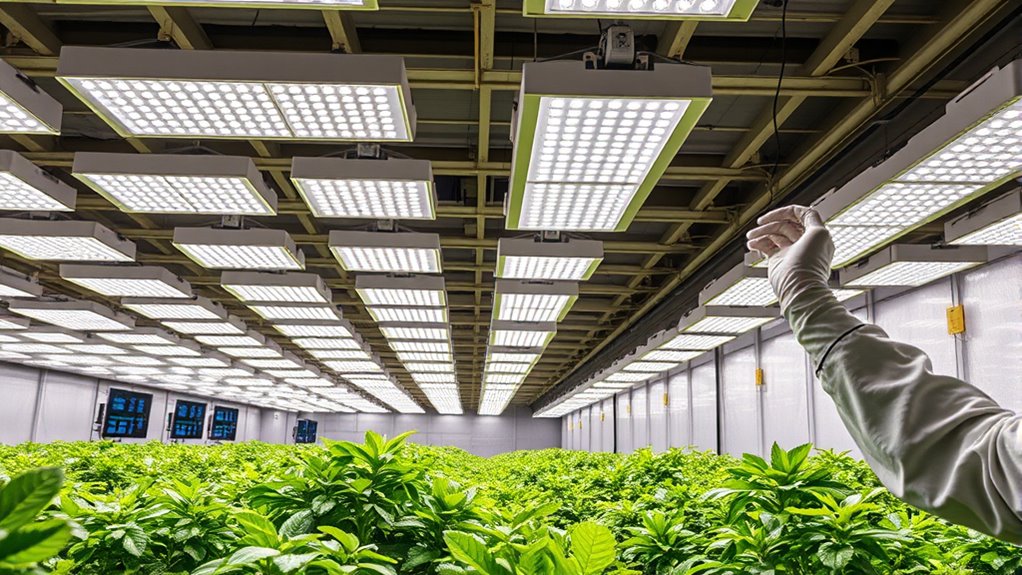
You need to regularly check your grow lights to guarantee they’re functioning properly. Adjust the light duration as your plants grow and conditions change, so your plants get the right amount of light. Keep an eye out for equipment issues to prevent malfunctions that could disrupt your plant growth. Incorporating automation into your lighting system can help optimize light schedules and reduce manual adjustments. Additionally, understanding family influences and cultural heritage can inform your approach to sustainable and culturally respectful gardening practices. Staying informed about security measures can also help protect your equipment from theft or vandalism, ensuring your system remains operational. Regular maintenance and system monitoring are essential for early detection of potential problems and maintaining consistent growth conditions. Being aware of juice detox effects and shelf life helps in planning your nutrition and health routines, which can indirectly influence your energy levels for gardening activities.
Regular Light Checks
How often do you check your grow lights? Regular light checks are essential to guarantee your plants receive the proper light spectrum and consistent light duration.
You should inspect your system weekly to verify that bulbs are functioning correctly and emitting the right spectrum for ideal growth. Look for signs of dimming or flickering, which can indicate the need for replacement. Keep an eye on the positioning of lights to maintain even coverage across your plants.
Measuring light intensity with a PAR meter helps confirm your setup delivers consistent light levels. Adjustments may be needed if you notice uneven lighting or changes in plant health.
Regular checks help prevent issues and keep your greenhouse environment stable for healthy, vigorous growth.
Adjusting Light Duration
Monitoring and maintaining the appropriate light duration is crucial for ideal plant growth, as inconsistent lighting can lead to stunted development or stress. To achieve this, you need to manage your light cycle carefully, ensuring your plants receive the right amount of light and darkness each day.
Photoperiod management involves setting timers to regulate when your grow lights turn on and off, mimicking natural conditions or adjusting for specific plant needs. Regularly review and modify your schedule based on plant growth stages and environmental changes.
Using timers simplifies this process, preventing accidental over- or under-lighting. Consistent light duration helps plants develop strong roots, healthy foliage, and maximum yields.
Proper adjustment of your light cycle is essential for a thriving greenhouse environment.
Preventing Equipment Malfunctions
Regularly inspecting and maintaining your grow light system is essential to prevent equipment failures that could disrupt plant growth. Check for loose connections, damaged cords, and signs of wear to ensure electrical safety. Clean bulbs and fixtures to maximize bulb longevity and prevent overheating. Replace bulbs promptly when they dim or flicker to avoid uneven lighting. Use a maintenance schedule to stay ahead of potential issues. Here’s a quick overview:
| Inspection Task | Frequency | Key Focus |
|---|---|---|
| Check wiring & connections | Monthly | Electrical safety |
| Clean bulbs & fixtures | Bi-weekly | Bulb longevity |
| Replace faulty bulbs | As needed | Consistent light output |
Following these steps helps keep your system safe and efficient.
Common Mistakes to Avoid When Using Grow Lights
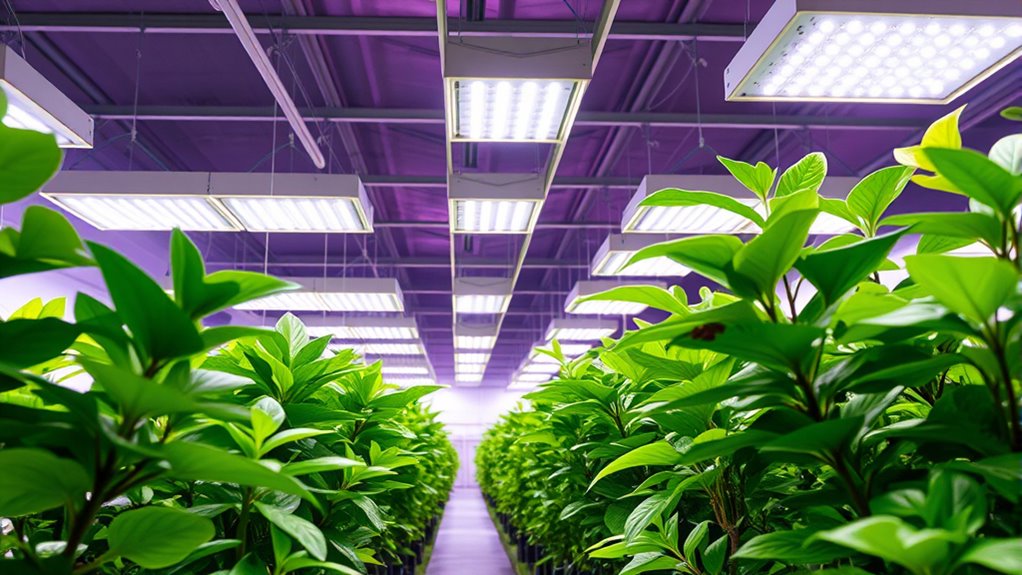
One common mistake is ignoring the importance of balancing the light spectrum, which can affect plant growth.
You also need to pay attention to the right duration of light exposure; too much or too little can harm your plants.
Ultimately, improper placement of grow lights can lead to uneven coverage and weak growth, so positioning matters.
Overlooking Light Spectrum Balance
Failing to pay attention to the light spectrum balance can hinder your plants’ growth and development. An uneven light spectrum, or light spectrum imbalance, can cause issues like weak stems, poor flowering, or stunted growth.
Different plants require specific light wavelengths to thrive, so providing a balanced spectrum is crucial for ideal results. Additionally, neglecting photoperiod management—how you adjust light exposure over time—can disrupt natural growth cycles.
Without proper spectrum balance, your plants mightn’t receive the necessary blue and red light for healthy photosynthesis. To avoid this mistake, choose grow lights that offer full-spectrum or customizable options, and regularly monitor the light quality to ensure your plants get the right wavelengths for each stage of growth.
Ignoring Light Duration Needs
Ignoring how long your plants need light can severely impact their growth. Proper light duration is essential for maintaining ideal photoperiod management, which influences flowering, vegetative growth, and overall health.
If you don’t provide the right light cycle, plants may become stressed, stretch excessively, or fail to produce flowers. Too much light can cause light stress, while too little can stunt growth.
To prevent this, you need to understand each plant’s specific photoperiod needs and adjust your grow lights accordingly. Consistent light duration helps mimic natural conditions and ensures plants receive the right signals for growth and development.
Forgeting to manage light duration can lead to poor yields and unhealthy plants, so always monitor and tailor your light schedule precisely.
Neglecting Proper Placement
Neglecting proper placement of your grow lights can substantially hinder plant development. If lights are too far, your plants won’t receive enough light intensity, slowing growth and reducing yields.
Conversely, placing lights too close can cause heat stress or damage to leaves. It’s vital to consider the light spectrum to guarantee your plants get the right wavelengths for photosynthesis.
Proper placement ensures an even distribution of light, preventing shaded areas and uneven growth. Adjusting light height based on plant size and growth stage optimizes light intensity, promoting healthy development.
Always monitor your plants for signs of light stress and adjust accordingly. Avoiding these placement mistakes helps maximize the benefits of your grow lights, guaranteeing healthy, vigorous plants in your greenhouse.
Tips for Maximizing Plant Health and Productivity

To maximize plant health and productivity with grow lights, it’s vital to tailor your lighting setup to your plants’ specific needs. Regular plant pruning encourages healthy growth and guarantees light reaches all parts of the plant, boosting photosynthesis.
Tailoring your grow light setup and regular pruning boost plant health and productivity.
Additionally, maintaining proper soil nutrition supports vigorous growth and flowering, making your plants more resilient under grow lights. Adjust your light intensity and duration based on the growth stage—seedlings need less light, while flowering plants require more.
Monitoring your plants closely helps identify signs of stress or nutrient deficiencies early. Combining these practices ensures your plants receive ideal conditions, resulting in stronger, healthier growth and higher yields.
Proper pruning and soil care, aligned with your lighting strategy, are key to maximizing productivity.
Frequently Asked Questions
How Energy-Efficient Are Different Types of Grow Lights?
When comparing grow lights, you’ll find LED efficiency surpasses HID lights, making LEDs more energy-efficient. LEDs use less power while delivering the same or better light output, reducing your energy costs.
HID lights, which include halogen and high-pressure sodium, consume more electricity and generate more heat. So, if you’re looking to save on energy and lower utility bills, LEDs are the better choice due to their superior efficiency and longer lifespan.
Can Grow Lights Be Used for Outdoor Greenhouse Applications?
They say, “If you want something done right, do it yourself.” Grow lights can be used for outdoor greenhouse applications, providing sunlight supplementation when natural light is insufficient.
Make certain they’re outdoor compatible, with weather-resistant features, so they withstand the elements.
Using grow lights outdoors helps you extend your growing season, but always consider your specific light needs and local climate to guarantee success.
What Safety Precautions Should I Take When Installing Grow Lights?
When installing grow lights, you should prioritize electrical safety by ensuring all wiring is properly insulated and grounded to prevent shocks.
Keep the area well-ventilated to avoid heat buildup and reduce fire risk.
Use waterproof fixtures and outlets rated for high humidity environments.
Always follow manufacturer instructions, and consider consulting a professional electrician if you’re unsure about electrical connections to keep your setup safe.
How Do I Troubleshoot Common Issues With Grow Light Systems?
When troubleshooting grow light systems, start by checking the power supply and connections for secure contact.
If plants aren’t thriving, verify if the grow light intensity matches your needs, and adjust if necessary.
Also, confirm your light spectrum is suitable; some plants require specific wavelengths.
If lights flicker or don’t turn on, replace faulty bulbs or check timers.
Regular maintenance helps keep your system functioning at its best.
Are There Specific Grow Lights Suitable for Certain Plant Species?
Think of your plants as travelers needing the perfect map. Some thrive under specialized spectrum grow lights that mimic natural sunlight, while others benefit from plant-specific lighting tailored to their unique needs.
By selecting grow lights with the right spectrum, you guide each plant on its journey to health and productivity.
Matching light types to plant species ensures they get the crucial energy, boosting growth and vitality.
Conclusion
By selecting the right grow lights and placing them thoughtfully, you set the stage for thriving plants. When you adjust their intensity and monitor performance, you create a natural rhythm that mirrors the seasons. It’s no coincidence that such attentive care leads to healthier, more productive plants—your greenhouse becomes a vibrant oasis. With a little practice, your green thumb will turn these coincidences into consistent success, transforming your space into a lush, thriving sanctuary.
